Painting a Plastic Bathtub in 4 Steps & Success Tips
Author: Omar Alonso | Editor: Omar Alonso
Review & Research: Jen Worst & Chris Miller

Does your bathtub have an unsightly yellow ring around it? You may have moved into a new home with a grubby-looking tub. Or perhaps you want to redecorate the bathroom and you're tired of the color of your tub? Painting a plastic bathtub is an effective way to give your bathroom a new look.
Is it possible to paint plastic? Or is it going to result in big bubbles that look terrible? The last thing you want to do is invest time and money in the project only to have it produce undesirable results for your effort.
This post unpacks everything you need to know about repainting plastic bathtubs. It's easier than you think, and you'll get impressive, lasting results with the right method.
Is My Bathtub Acrylic or Plastic? – How to Tell the Difference
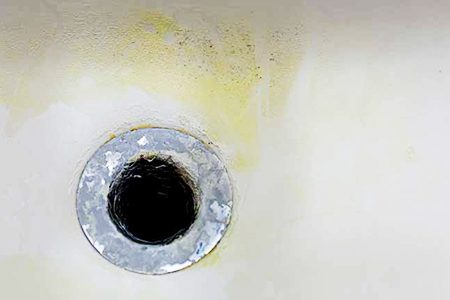
Most manufacturing brands use acrylic and plastic materials for bathtubs. Acrylic is more expensive than plastic because the manufacturing process doesn't involve chloride. In contrast, plastic contains chloride, and this chemical leaches out of the plastic material over time.
Chloride discolors the bathtub over time, which is why a white bathtub can develop a yellowish tinge over time with exposure to light and heat, especially. If you're dealing with a discolored tub, chances are its plastic, not acrylic. This is the easiest way to tell what types of bathtubs you have in your home. After painting the tub, you won't have the same discoloration problem.
How to Paint a Plastic Bathtub in 4 Steps
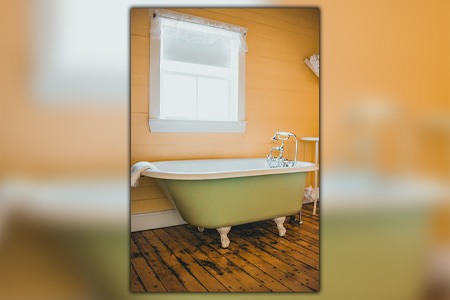
Here's our step-by-step process for painting your plastic bathtub. It works for changing the tub's color or painting a plastic shower basin, plastic tub surround, etc. So can you paint a plastic tub surround? Yes, just follow the procedure.
Step 1 – Clean Your Plastic Bathtub
You'll need to clean the tub property before starting the repainting job. Remove all the soap, sponges, washcloths, and other bathing accessories from around the tub. If you have a handheld shower head attached to the tub, it's a good idea to remove it and refit it after you finish refurbishing it.
Next, mix up some degreasing formula. Use a degreasing product that's environmentally friendly and safe for draining out of the bathtub into the municipal water supply. Look for eco-friendly options online or at your local hardware store or big-box retailer.
Step 2 – Tape Off the Bathtub
Painting a tub gets messy. Using a compressor and sprayer, you'll likely end up over-spraying around the edge of the fittings. Or you could accidentally lose your concentration and over-paint if you're using a brush.
Tape off the tub, the drain, and the fittings to prevent the finished job from looking like a dog's breakfast. While removing paint from tiles is easy, getting it off the grouting is more challenging.
Step 3 – Sand the Tub & Prime it for Paint
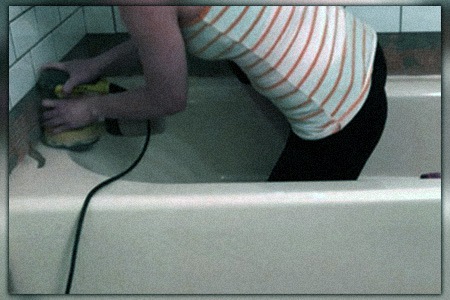
It's time to sand and prime the bathtub surface and prepare it for paint. For the paint to adhere properly, you'll need a plastic epoxy remover or chemical stripper safe for bathtubs. Apply the stripper and let it work for the recommended time. Ensure you wear a respirator, goggles, and gloves when applying the stripper.
Let the surface dry, and you're ready to start sanding. Use 180-grit sandpaper for the task. Manufacturers don't paint the tub; they infuse pigment into the plastic to give it color. So, it's not necessary to sand it hard. Just give the tub a good once-over with the sandpaper by hand or using a sanding block. Don't use any power types of sanders as you can't fix a mistake.
This task slightly roughens the surface, giving the paint something to adhere to when applying it to the surface. Wipe down the tub afterward to remove all traces of plastic and stripper or remover. Next, use a primer base to allow the paint to stick to the surface. Primers are available in spray-can format, and they're easy to apply. You only need one light coat.
Step 4 – Paint the Plastic Bathtub
Now you're ready to start painting the plastic bathtub. You can use a compressor and sprayer to spray the tub or cans of spray paint. If you don't have access to these products, you can also use a brush, which leaves more room for error in the process. Spray paint gives you the best finish and look.
Choose your paint and spray it on the tub. Covering the area takes around two to three cans of paint per coat. Be careful at the edges and try to limit your overspray. Ensure you place a plastic drop cloth around the tub's edges and the floor, and use masking tape to create a clean line.
Most spray paints only require a single coat, but you can add a second after waiting 24 hours for it to dry. You can get creative with the process and use two-tone paints to give an impressive visual effect.
For instance, you could paint the tub white and use light sprays of blue or green around the sides to create a stippled effect. After you finish painting, remove the masking tape, and give it 24 hours to dry. You can follow this same procedure to paint your toilet.
What's the Best Paint for a Plastic Bathtub?
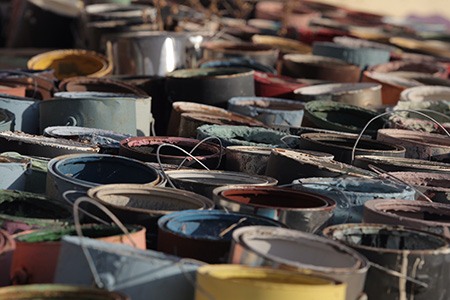
You can use many types of paint on the plastic bathtub given they adhere to the tub surface, are water-resistant, and durable. Epoxy acrylic paint is the best plastic bathtub paint and looks more like porcelain once dry. Note that you should use any types of primer paint first with epoxy acrylic paint.
We recommend spray paint because it has the most even application and is easy to work with for the task. Keep the nozzle the recommended distance from the tub and spray in long lines when painting.
Don't overspray the tub, or the paint will run. We recommend giving the tub two or three passes. Paint one pass, leave the paint to dry for a few hours, then do a second and third pass. This strategy prevents runs in the finish when painting a plastic bathtub.
Can You Resurface Plastic Bathtubs?
Yes, you can resurface plastic bathtubs. Resurfacing bathtubs is a common DIY project, especially in older properties. Bathtubs are expensive to buy, and with the right resurfacing methods, you can save hundreds of dollars on your bathroom remodel costs.
Can I Use Enamel Paint on a Plastic Bathtub?
We don't recommend you use enamel paint or latex paint. Latex paints will bubble and pull away from the surface. Enamel paints will likely melt the plastic material. Latex paint is usually thinner than enamel paint, requiring more coats for an effective finish. However, we recommend you stick to spray paint for the best results.
Using the Correct Painting Technique
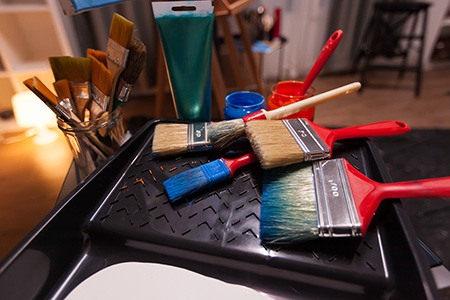
We highly recommend you avoid using a hand brush to paint your tub. You won't get the desired result. All it takes is one paintbrush hair stuck in the paint to make a mess of the job. Nothing can compare to the convenience spray paint offers for the task.
You don't have to hire a sprayer and compressor for the task. Just buy some spray paint cans. You have options for primers and paints in spray cans, and it's an affordable option. You should need one can of primer and two to three cans of paint for the job.
Spray paint is available in a huge range of colors. Make sure you're buying the same color, as it's easy to confuse the shades when purchasing in a hardware store. DIY newbies' biggest issue with painting their bathtubs is using the correct technique when handling spray cans.
Don't get too close to the surface, or you'll create runs. A good strategy is to take the cans outside and do a couple of practice runs on some other material, like a plastic drop cloth. Once you're confident you have the right technique, you can start painting the tub.
Don't over-concentrate on one area of the tub. Paint in long, straight lines and go back and forth along the tub's length for the best results. If you absolutely must use some types of paint brushes instead of spray paint, consider using a small roller for the large surfaces and foam brushes for hard to reach spots.
How to Get a Smooth Finish When Painting Plastic Bathtubs
Prepping the bathtub's surface using the right method is the best way to ensure you get outstanding results from your DIY project. Clean the tub, add your stripping agent, give it time to work, and sand the tub lightly to help the primer stick to the surface.
Remember to give the primer the correct drying time. Don't apply the paint until your primer is completely dry. Most products require a minimum of a four-hour drying time, but we recommend leaving it to dry overnight.
Don't use the shower in the bathroom during the drying process. Adding humidity to the air will affect the primer and its bond to the plastic.
Should I Hire a Professional or Do a DIY Job?
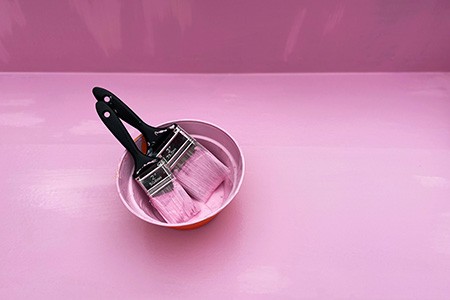
Painting a plastic bathtub is a great way to refurbish an old, stained bathtub without going to the expense of buying a replacement. You get a cost-effective means of updating the tub's look and bathroom aesthetic.
Many old tubs have discoloration and look terrible, especially white colors. Also, the previous owner might have abused the tub, leaving rings around the inside or other ugly effects. Using the method in this post to recondition the tub with spray paint gives it a brand-new look.
Some older tubs might also have cracks, scratches, or dents. Peeling bathtubs are very common, too. If so, you can repair the problems and repaint the tub, leaving it looking like new instead of an eyesore in the bathroom. Here's our guide on plastic bathtub crack repair if you want to do it yourself.
If you're uncertain about your handy capabilities, you can always call a professional to handle the task for you. Typically, you can expect to pay between $80 to $120 per hour for a handyman to finish the refinishing work, and their work should come with a guarantee. It could take four to six hours to finish the job, so account for that in your project budget. A normal range for the total price would be between $335 and $630 in the USA.
Painting a Plastic Bathtub is Something You Can Do!
So can you paint a plastic bathtub? As long as the plastic tub doesn't have extreme problems like pitting, cracks, and other surface vulnerabilities, painting a plastic bathtub isn't difficult. It's a chore, of course, but an interesting one. The difficulty level is very low, so please have confidence that you can do it, because you can.



